Amman
| Amman عمان ʿAmmān |
|||
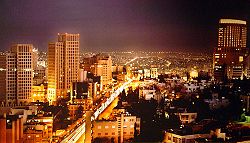 |
|||
|
|||
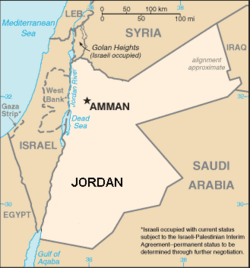 |
|||
| Country | Jordan | ||
|---|---|---|---|
| Governorate | Capital Governorate | ||
| Government | |||
| - Mayor | Omar AlMaani | ||
| Area | |||
| - Total | 1,680 km² (648.7 sq mi) | ||
| - Land | 700 km² (270.3 sq mi) | ||
| Elevation | 773 m (2,356 ft) | ||
| Population (2005)[1] | |||
| - Total | 2,125,400 | ||
| 1. Population refers to Greater Amman | |||
| Website: http://www.ammancity.gov.jo | |||
Amman (pronounced [ɑˈmɑːn]), sometimes spelled Ammann (Arabic عمان ʿAmmān), is the capital city of the Hashemite Kingdom of Jordan, a city of 2,125,400 inhabitants (2005 estimate), and the administrative capital and commercial center of Jordan. It is also the largest city in Jordan. It is the capital city of Amman Governorate.
Contents[hide] |
History
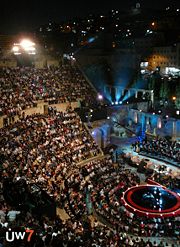
Throughout history, Amman has been inhabited by several civilizations. The first civilization on record is during the Neolithic period, around 8500 BC, when archaeological discoveries in 'Ain Ghazal, located in eastern Amman, showed evidence of not only a settled life but also the growth of artistic work, which suggests that a well-developed civilization inhabited the city at that time. In the 13th century BC Amman was called Rabbath Ammon or Rabat Amon by the Ammonites (רַבַּת עַמומּוֹן, Standard Hebrew Rabbat ʿAmmon, Tiberian Hebrew Rabbaṯ ʿAmmôn). It was later conquered by the Assyrians, followed by the Persians, and then the Greeks. Ptolemy II Philadelphus, the Hellenic ruler of Egypt, renamed it Philadelphia. The city became part of the Nabataean kingdom until 106 AD when Philadelphia came under Roman control and joined the Decapolis.
In 326 AD, Christianity became the religion of the empire and Philadelphia became the seat of a bishopric during the beginning of the Byzantine era. One of the churches of this period can be seen on the city's Citadel.

Philadelphia was renamed Amman during the Ghassanian era, and flourished under the Caliphates (with nearby capital) of the Umayyads (in Damascus) and the Abbasids (in Baghdad). It was then destroyed by several earthquakes and natural disasters and remained a small village and a pile of ruins until the Circassians settlement in 1887. The tide changed when the Ottoman Sultan decided to build the Hejaz railway, linking Damascus and Medina, facilitating both the annual hajj pilgrimage and permanent trade, putting Amman, a major station, back on the commercial map.
In 1921, Abdullah I chose Amman as seat of government for his newly-created state, the Emirate of Transjordan, and later as the capital of the Hashemite Kingdom of Jordan. As there was no palatial building, he started his reign from the station, with his office in a train car. Amman remained a small city until 1948, when the population expanded considerably due to an influx of Palestinian refugees from what is now Israel. Amman has experienced exceptionally rapid development since 1952 under the leadership of two Hashemite Kings, Hussein of Jordan and Abdullah II of Jordan.
In 1970, Amman was the site of major clashes between the Palestine Liberation Organization (PLO) and the Jordanian army. Everything around the Royal Palace sustained heavy damage from shelling. Most of Amman suffered great damage from PLO rockets and the Jordanian army's shells.
The city's population continues to expand at a dizzying pace (fueled by refugees escaping the wartime events in the occupied territories and Iraq). The city received refugees from these countries on a number of occasions. The first wave of Palestinian refugees arrived from what is now Israel in 1948. A second wave after the Six-Day War in 1967. A third wave of Palestinian and Jordanian and Southeast Asians, working as domestic workers, refugees arrived in Amman from Kuwait after the Gulf War of 1991. The first wave of Iraqi refugees settled in the city after the first Gulf War, with a second wave also arriving after the 2003 invasion of Iraq. During the last 10 years the number of new buildings within the city has increased dramatically with new districts of the city being founded at a very rapid pace (particularly so in West Amman), straining the very scarce water supplies of Jordan as a whole, and exposing Amman to the hazards of rapid expansion in the absence of careful municipal planning.
On November 9, 2005, coordinated explosions rocked three hotels in Amman, resulting in the death of 60 people and the injury of 115 others. Al-Qaeda claimed responsibility responsibility for the act, which was carried out despite the fact that the birthplace of since-killed Al Qaeda terrorist leader Abu Musab al-Zarqawi, is the town of Zarqa, less than 30 km (19 mi) from Amman. The sheer brutality of the attacks, which targeted, amongst other things, a wedding party being held at one of the hotels, caused widespread revulsion across the widest range of Jordanians. Large protests and vigils followed in the wake of the attacks.
Geography
Amman is located in a hilly area of north-western Jordan, and is at an elevation of 773 meters (2,356 feet). The city was originally built on seven hills, but it now spans an area of over nineteen hills (each known as a jabal or "mountain"). Many of Amman's districts derive their names from the name of the mountain they are built on.
Because of the cooling effects of its location on a plateau, Amman enjoys a Mediterranean climate and four seasons of excellent weather as compared to other places in the region. Summer temperatures range from 28 °C (82 °F) - 35 °C (95 °F), but with very low humidity and frequent breezes. Spring and fall temperatures are extremely pleasant and mild. The winter sees nighttime temperatures frequently near 0 °C (32 °F), and snow is known in Amman, as a matter of fact it usually snows a couple of times per year. The yearly average number of days with rain is 5-45 and with snow it is 0-8. It typically will not rain from June to the beginning of September, with cloudless blue skies prevailing. But lately it is starting to rain in April and the beginning of May. In fact about half the quantity of rain Amman and Jordan received in 2006 fell in April.
| [hide] |
|||||||||||||
|---|---|---|---|---|---|---|---|---|---|---|---|---|---|
| Month | Jan | Feb | Mar | Apr | May | Jun | Jul | Aug | Sep | Oct | Nov | Dec | Year |
| Average high °C (°F) | 12.2 (54) |
13.5 (56) |
17.0 (63) |
22.7 (73) |
27.6 (82) |
30.5 (87) |
32.1 (90) |
32.1 (90) |
30.5 (87) |
26.5 (80) |
19.7 (67) |
14.2 (58) |
32.1 (90) |
| Average low °C (°F) | 3.9 (39) |
4.5 (40) |
6.6 (44) |
10.2 (50) |
14.2 (58) |
17.5 (64) |
19.7 (67) |
19.4 (67) |
17.6 (64) |
14.5 (58) |
9.3 (49) |
5.5 (42) |
3.9 (39) |
| Rainfall mm (inches) | 60.0 (2.36) |
58.5 (2.3) |
44.0 (1.73) |
8.3 (0.33) |
2.8 (0.11) |
0.1 (0) |
0.0 (0) |
0.0 (0) |
0.1 (0) |
8.3 (0.33) |
26.2 (1.03) |
50.0 (1.97) |
258.3 (10.17) |
| Source: [2] 2008-02-27 | |||||||||||||
Districts
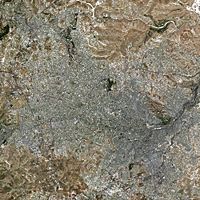
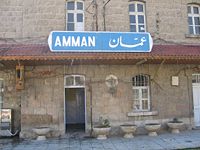
The following is a list of districts that make up the Greater Amman Municipality (GAM)[3]:
| District Name | |
|---|---|
| 1 | Al Abdali |
| 2 | Abu Nseir |
| 3 | Al Nusr |
| 4 | Al Qweismeh, Al Jweideh, Abu ‘Alanda and Al Raqim |
| 5 | Al Yarmouk |
| 6 | Al-Jezah |
| 7 | Al-Mowaqar |
| 8 | Al-Mqabalain |
| 9 | Badr |
| 10 | Badr Al Jadeeda |
| 11 | Basman |
| 12 | Husban |
| 13 | Jbeiha |
| 14 | Khraibet Essouq |
| 15 | Marj Al Hamam |
| 16 | Marka |
| 17 | Medina |
| 18 | Nawoor (Na'our) |
| 19 | Ohud |
| 20 | Ras Al-ain |
| 21 | Sahab |
| 22 | Shafa Badran |
| 23 | Sweileh |
| 24 | Tariq |
| 25 | Tla’ Al ‘Ali |
| 26 | Wadi Al Seer |
| 27 | Zahran |
Transportation
- See also: Transport in Jordan and List of roads in Amman

The city's largest airport, Queen Alia International Airport, situated about 30 minutes south of Amman, is the major international airport for Jordan and the hub for Royal Jordanian, the flag carrier. The airport has three terminals, two passenger and one cargo, and in 2007 handled between 4 to 5 million passengers. The airport is undergoing expansion, including a new terminal costing $600M, that will allow the airport to handle over 9 million passengers. A new rail line being constructed will connect Queen Alia International with Raghadan, Mahatta, and Zarqa. Taxis and buses serve the airport 24/7.
Marka International Airport is a one-terminal airport that serves primarily domestic and nearby international routes and the military.
The recently constructed Abdoun Bridge spans Wadi Abdoun, and connects the 4th Circle to Abdoun Circle. It is considered one of Amman's many landmarks.
The Hejaz railway, built in the early 20th century, was used primarily for pilgrims to reach the holy cities of Mecca and Medina, but now the rail line is basically used by tourists. There are new projects that are being built to add more railines in the Kingdom, most of which will go through Amman.
There are plans to construct a metro line in Amman. The first phase would connect University of Jordan Street with Raghadan. Then from Raghadan to Airport Road. The project would cost more than half a billion dollars,
Amman has a extensive highway system that links every part of the city to one another. Its highways also link nearby cities such as Zarqa and Madaba. The Amman-Zarqa highway becomes very congested with commuters at rush hour which is why a new commuter rail line is being constructed. Amman also has an extensive bus system. There are pedestrian tunnels that bring pedestrians from one side of a highway to another.
There are eight circles, or roundabouts, that span and connect West Amman. However, the city lacks an operable rail or metro system which causes severe congestion in the city, especially in old Amman, where its narrow streets cannot handle many people. To add to the congestion, all the Kingdom's highways pass through Amman, further increasing traffic in the capital.
By land, the city has frequent bus connections to other cities in Jordan, as well as to major cities in neighboring countries; the latter are also served by service taxis. Internal transport is served by a number of bus routes and taxis. Service taxis, which most often operate on fixed routes, are readily available and inexpensive. The two main bus and taxi stations are Abdali (near the King Abdullah Mosque, the Parliament and Palace of Justice) and the newly built Raghadan Central Bus Station (near the Roman Amphitheater in downtown). The city can suffer from considerable traffic congestion at peak hours, especially during summer months when affluent vacationers from the Gulf region summer in Amman to take advantage of its relatively mild weather.
Economy
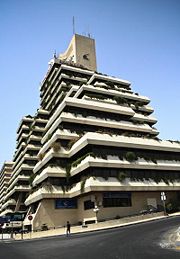
Amman is a regional hub in communications, transportation, medical tourism, education, and investment. Amman is aggressively positioning itself as a hub for business, and new projects are continually transforming the city's skyline. Following the 2003 Iraq War, all business dealings with Iraq flow through Amman in some way. Its airport, Queen Alia International Airport, is the hub of the national carrier, Royal Jordanian, which is a major airline in the region. Amman is a major tourist gateway in the country because most of the country's foreign tourists arrive in Jordan through Amman. Amman is currently experiencing rapid growth in many different areas, with large growth seen in the real estate, construction, banking, finance and business sectors. Numerous skyscrapers are under construction as the city municipality recently lifted the ban of buildings taller than 4 stories and allocated designated areas for high rises. All major highways of Jordan cross in Amman making the capital busy with freight trucks, buses and cars passing through the city.
Amman has both a modern and historic touch. East Amman is the older part of the capital where single family dwellings on the hill side and small shops and bazaars in the wadis, or valleys, dominate East Amman's layout. Old Amman is filled with souks, or bazaars, small shops, and single family dwellings all.
Several industrial cities are being developed near Amman, most important being Al-Mushatta, poised at turning this once sleepy village into a global economic powerhouse.
West Amman, however, is less densely populated and more scenic. It is also the more prosperous part of Amman, with much of the city's economic activity being centered in West Amman. Parks and wide boulevards with towering apartments and office buildings dominate the scenery. Most of the city's 5-star and 4-star hotels are located in West Amman. Important districts include Shmeisani and Abdali, the main economic centers of Amman, Abdoun, the up-scale residential district, and Jabal Amman, one of Amman's historic districts. A large contrast exists between the more affluent districts of West Amman and the more middle and working class districts of East Amman.
Amman has a very large expatriate population because of its reputation as a haven for refugees seeking political asylum. Iraqis, Palestinians, Lebanese, Armenians, Circassions, and Chechens are among the many different expatriate populations currently residing in Amman. Egyptians, Syrians, and South East Asians also reside in vast numbers that work as domestic or civil servants. Many Westerners currently reside in Amman as many international organizations and diplomatic missions have regional offices in Amman.
New projects and proposals in and around the city include:
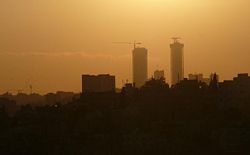
- The Abdali Downtown project: this new development in the heart of Amman is among the largest projects under construction in the kingdom, and is a mixed-use development consisting of retail, outdoor shopping and restaurants, residential and office buildings. The master plan includes a large public green park, along with an outdoor pedestrian strip [4]. The first phase of the project is expected to be completed by 2010.
- The construction of the American University of Jordan.
- The construction of the Jordan Gate Towers near the 6th Circle, which is nearly completed, is being funded by Bahraini and Kuwaiti entrepreneurs. The two identical skyscrapers will house office buildings.
- Bonyan city, which will consist of 5 new skyscrapers that will house apartments and offices
- The Heights Tower, consisting of 35 floors, will house apartments and it is currently under construction.
- Sky Tower, a residential tower consisting of 30 floors, is under construction.
- Amman Financial Tower, consisting of 56 floors, has been approved for construction.
- Betina City consists of 3 central skyscrapers, a mega-mall, a suspended river, and 3 additional towers.
- The Limitless Towers, two identical 65 floor buildings connected by a pedestrian walkway that will house the world's highest swimming pool. This twin tower project will be built in Abdoun.
- The Abdoun suspended bridge, which spans Wadi Abdoun. This recently completed project reduces congestion in Wadi Abdoun and creates a new highway link between West and South Amman.
- The expansion of Queen Alia International Airport.
- The Jordan Twin Towers, which are to be constructed by the Nuqul Group, and will be 34 stories high. Expected to be complete by 2008.
- The Andalucian Village, being constructed near Amman. This project will include over 600 villas, and consists of many facilities such as spas, fitness and health centers, swimming pools, and a recreation area to be completed by 2008. 64% of the village have already been sold.
- A proposed Amman World Trade Center, which will consist of 33 floors.
- A massive new Royal Jordanian headquarters
These projects, along with the boom in the Jordanian real estate market and the construction of numerous other projects, are resulting in a huge boom in terms of development, both in the city of Amman and in the Hashemite Kingdom of Jordan as a whole.
- Further information: List of tallest buildings in Amman
Cost of Living
Prices have skyrocketed in the past 5 years. Amman was ranked by the Economic Intelligence Organization to be the most expensive city in the Arab World, even ahead of places like Dubai and Beirut. Real estate has skyrocketed due to a number of Wealthy Iraqis resettling in Amman. Real estate continues to be the dominating investment sector in Amman.
Culture
Amman is one of the most liberal cities in the Middle East. Its culture and arts scene is thriving. Its freedom of worship is a long standing tradition of Jordan. The Jordanian media is also one of the most unrestricted in the region. Jordan has no laws forcing women or men to dress in a particular way. Women are not required to wear the veil. However, Appropriate attire is expected around places of worship of both the Islamic and Christian faiths. Amman is home to many diverse religious sects making up the two primary religions of Jordan, Islam and Christianity. Numerous mosques and churches dot the capital. The most famous mosque of Amman is the King Abduallah I Mosque which can house almost 3,000 people. Most of the people in Jordan are Muslims, 90% and 10% Christians.
Numerous cultural centers can be found throughout Amman, most notably the Al Hussein Cultural Center which contains over 30,000 books and plans to double that number, 30 computer sets, an electronic library and specialized libraries. Numerous IT and library centers can be found throughout the city.
The Al al-Bayt Institute Building located in the Al Hussein Public Parks points to the importance that the Hashemites give to the role of the Institute in Islamic life. Moreover, it is in line with the vision expressed by the Late King Hussein as far as the enrichment of man’s life with all sorts of knowledge. Care was taken to emphasize the Islamic character of the project: internally, the theme is unity of elements, leading to an inner courtyard; the use of cellars, arches in roofing, and proportionality, breakage of continuity of entrances as an element of creating anticipation, in addition to the use of wood and metal in overlapping fashion whereby, in the end, a distinctly Islamic style is reflected. Externally, a viewer looking at the external façade will note the extensive use of arches and Islamic oriels which give the building a reflection from the inside out, as well as a particularity that differs from the urban texture, not only as a religious or cultural function but as a school of all Islamic architectural elements.
The Cultural Village in the Al Hussein Public parks aims at introducing our heritage and Jordanian culture to visitor through a set of handicrafts created by a group of professional artisans and innovative institutions. The project consists of a main square surrounded by shops and galleries. On the eastern side of the village there is a coffee shop and two restaurants with a view overlooking the city.
There are numerous museums in Amman including the Royal Automobile Museum, the Jordan Archaeological Museum, Jordan Museum of Popular Tradition, the Jordan Folklore Museum, Souk jara, and the Jordan National Gallery of Fine Arts.
The Automobile Museum houses and exhibits the Late King’s collection of automobiles. The design of the building comes across as a mass merging into the surrounding environment and blends with it through the artificial planted hills which rise beyond the building’s walls.
The Jordan Archaeological Museum is located at the Citadel and houses it houses archaeological treasures from across the country like pottery, jewellery, ancient tools, etc. It also houses The Dead Sea bronze scrolls and plaster statues from Ain Ghazal, one of the world's oldest settlements.
The Jordan Museum of Popular Tradition and the Jordan Folklore Museum exhibit Jordanian handicrafts, clothing, embroidery, musical instruments,a goat hair Bedouin tent furnished with traditional objects, as well as a collection of mosaics from Madaba and other Byzantine churches across the country
The Jordan National Gallery of Fine Arts exhibits Jordanian art as well as art from across the region and the world. The museum in Jabal Lubweideh houses art even from Europe and America as well.
Media
Many Jordanian newspapers and news stations are situated in Amman. Amman is also a popular entry point for journalists entering the region to broadcast breaking news from volatile nations like Iraq and the Palestinian territories.
The Jordan Media City, established in 2001, is the first of its kind in the region and plans to make Jordan the regional hub of communications. It now transmits over 120 channels and still grows. Most channels are not Jordanian based, and the government still possess restrictions on Jordanian based channels which makes it hard to open new Jordanian TV channels. Although not as popular as Beirut or Cairo, many Jordanian singers work out of Amman.
Tourism

Much of Amman's tourism is focused in the older downtown area, which is centered around the old souk (a colorful traditional market) and the King Hussein Mosque. The downtown area (known locally as the Balad) has been completely dwarfed by the sprawling urban areas that surround it. Despite the changes, much remains of its old character. For those seeking the atmosphere of the Old City, it is best to venture to the district east of Jabal Amman. There, in the bustle of daily life, you can explore the capital's greatest souks, fine museums, ancient constructions, monuments, and cultural sites.
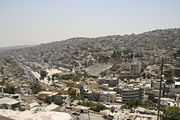

The Citadel hill of Amman, known as Jabal el Qala, has been inhabited for centuries, important as a military and religious site. It dates back to Roman and Byzantine times, and later work was carried out in the early Islamic era. Remains unearthed at the northern and eastern ends of the Citadel, possibly date back to the Bronze Age. The Citadel also is home to the Temple of Hercules which is said to have been constructed under the Roman Emperor Marcus Aurelius who reigned from 161-180 AD, is similar to the Temple of Artemis in Ephesus.
Since Amman resembles Rome, as it is situated on seven hills, the city was a favorite place for Roman soldiers and officials. Behind the Roman forum stands a Roman theatre — the largest theatre in Jordan — with room for 6,000 spectators. Thought to have been built between 138 and 161 AD by the Roman Emperor Antoninus Pius, it is constructed into the side of the mountain and is still used for sports displays and cultural events.
Amman is also home to some of the grandest mosques in the Middle East, although they compare less favorably to the ones to be found in Istanbul, Turkey. The newest of these is the enormous King Abdullah I Mosque, built between 1982 and 1989. It is capped by a magnificent blue mosaic dome beneath which 3,000 Muslims may offer prayer. The most unusual mosque in Amman is the Abu Darweesh Mosque atop Jabal Ashrafieh (the highest point in the city). It is covered with an extraordinary black and white checkered pattern and is unique to Jordan. It is striking and visible from quite some distance. In contrast, the interior is totally free of the black and white scheme. Instead, there are light colored walls and Persian carpets. This religious building was erected by one of Amman's Circassian immigrants.
Amman is also home to many jewelers and souvenir shops for citizens and tourists alike. Most of Amman is well paved and nicely renovated. A new phase in Eastern Amman, the oldest part of the city, will repaint and renovate broken down building and build kiosks and street maps all over to the city to make touring Amman much easier for tourists. Amman is also a major destination for foreign students seeking study in Arabic. Amman's world-class hospitals are frequent destinations for those who seek medical treatment.
A new construction phase in Abdali will transform downtown Amman into a more desirable place for investment. The new development is mostly for business purposes and the rest are residential hi-rises and shopping centers. Office buildings and a new boulevard containing easy access to malls, restaurants, hotels, and residential buildings. This $1.5 billion construction plan should be completed by 2010.
Unfortunately, a lone deranged gunman attacked Western tourists during a guided trip to the downtown Roman theatre in September 2006, shooting five of them, one fatally. The man was immediately apprehended, and claimed to have acted in response to the fighting between Israel and Lebanon during the prior months. Despite this attack, tourism in Amman continues on a daily basis, and the city's tourist locations are generally well-policed. Given Jordan's location in a region that sees frequent conflict and violence, by statistics and by general mood, Amman remains a safe and interesting place to visit. For example, despite this killing, there is little or no violent or petty crime in Amman, especially against visitors, who uniformly report feeling safe at all hours in practically all locations in the city.
Shopping
Shopping is continually becoming more popular in Jordanian culture and is very notable in the past five years, with huge mega malls across Amman popping up such as Mecca Mall, Abdoun Mall, Amman Mall, City Mall, Plaza Mall, and Al Baraka Mall. Amman's retail sector is booming as the city is becoming a hub for Western travelers in the Levant.
Wakalat Street is Amman's first pedestrian-only street. It is one Amman's most vibrant and popular shopping districts.
Amman's newest shopping malls carry label names, which help attract tourists.
Nearby places of interest
Amman is conveniently located for many Jordanian attractions favoured by tourists. It is a mere 45 minute trip by car to several interesting locations:
- The Baptism Site (Al-Maghtas in Arabic) on the Jordan River where Jesus is believed to have been baptized by John the Baptist
- Mount Nebo where, according to the Bible, Moses is supposed to have died
- The unique ultra saline waters of the Dead Sea, home to many first-rate resorts
- Jerash, a city of the Decapolis and considered one of the most important and best preserved Roman cities in the Near East
- The Hellenistic ruin of Qasr al Abd, in the near-by valley of Wadi Al Seer
- Petra, two hours from Aqaba, is one of the most breathtaking places in the world (one of the 7 wonders of the world)
- The beaches at Aqaba, a shipping port and Jordan's only access to the Red Sea. Just about three of four hours from Amman by car or 350 km (220 mi) away. You can also take a plane on Royal Jordanian from Queen Alia Airport to King Hussein International Airport (Aqaba Airport). The primarily industrial character of the town is mitigated by the fact that it is set between sprawling mountain ranges and boasts some of the finest coral reefs in the region.
- The unique geological rock formations of Wadi Rum. The colorful rocks are best viewed at sunset and located a half hour away from Petra. Wadi Rum has connections with T. E. Lawrence; consequently the movie Lawrence of Arabia filmed there for a number of scenes.
- Iraq Al Amir :Iraq Al Amir is situated in a lush, secluded wadi 24km to the southwest of Amman. The area is generally known for Qasr Al-Abd (palace of the Slave), an impressive and unique building which dates from the first quarter of the 2nd century BC. Originally two stories high and constructed of megalithic stones weighing from 15-25 tons each, it is the most striking Hellenistic monument that has survived on either side of the Jordan River
Picture Gallery
Sister cities
Amman's sister cities are: [5]
|
|
References
- ↑ Jordan Department of Statistics
- ↑ "Jordan Meteorological Department". Jordan Meteorological Department. Retrieved on February 27, 2008.
- ↑ Greater Amman Municipality Website
- ↑ The Abdali Boulevard
- ↑ "Amman’s Relations with Other Cities".
See also
- List of tallest buildings in Amman
External links
- Amman travel guide from Wikitravel
- 360 degrees panorama from the Citadel Hill in central Amman
- Amman interactive map
- Amman photo Gallery
- Amman photo Slideshow
- WikiTravel WikiTravel - Petra
|
||
|
||

